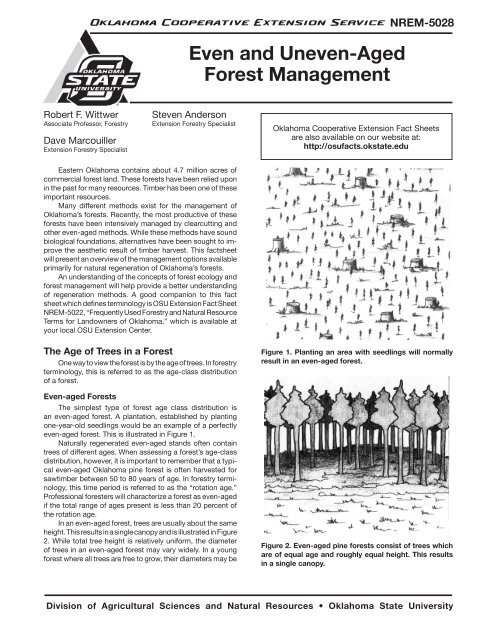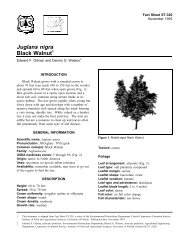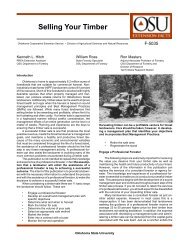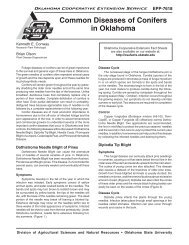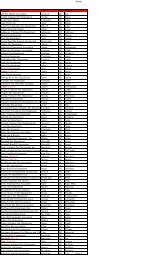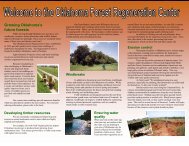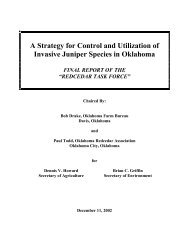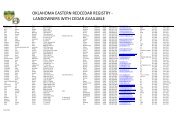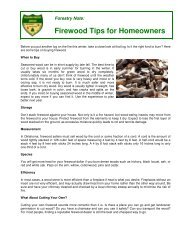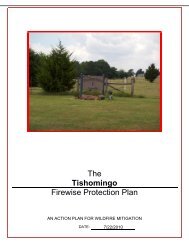Even and Uneven-Aged Forest Management - Oklahoma Forestry ...
Even and Uneven-Aged Forest Management - Oklahoma Forestry ...
Even and Uneven-Aged Forest Management - Oklahoma Forestry ...
Create successful ePaper yourself
Turn your PDF publications into a flip-book with our unique Google optimized e-Paper software.
<strong>Oklahoma</strong> Cooperative Extension ServiceNREM-5028<strong>Even</strong> <strong>and</strong> <strong>Uneven</strong>-<strong>Aged</strong><strong>Forest</strong> <strong>Management</strong>Robert F. WittwerAssociate Professor, <strong>Forest</strong>ryDave MarcouillerExtension <strong>Forest</strong>ry SpecialistSteven AndersonExtension <strong>Forest</strong>ry Specialist<strong>Oklahoma</strong> Cooperative Extension Fact Sheetsare also available on our website at:http://osufacts.okstate.eduEastern <strong>Oklahoma</strong> contains about 4.7 million acres ofcommercial forest l<strong>and</strong>. These forests have been relied uponin the past for many resources. Timber has been one of theseimportant resources.Many different methods exist for the management of<strong>Oklahoma</strong>’s forests. Recently, the most productive of theseforests have been intensively managed by clearcutting <strong>and</strong>other even-aged methods. While these methods have soundbiological foundations, alternatives have been sought to improvethe aesthetic result of timber harvest. This factsheetwill present an overview of the management options availableprimarily for natural regeneration of <strong>Oklahoma</strong>’s forests.An underst<strong>and</strong>ing of the concepts of forest ecology <strong>and</strong>forest management will help provide a better underst<strong>and</strong>ingof regeneration methods. A good companion to this factsheet which defines terminology is OSU Extension Fact SheetNREM-5022, “Frequently Used <strong>Forest</strong>ry <strong>and</strong> Natural ResourceTerms for L<strong>and</strong>owners of <strong>Oklahoma</strong>,” which is available atyour local OSU Extension Center.The Age of Trees in a <strong>Forest</strong>One way to view the forest is by the age of trees. In forestryterminology, this is referred to as the age-class distributionof a forest.<strong>Even</strong>-aged <strong>Forest</strong>sThe simplest type of forest age class distribution isan even-aged forest. A plantation, established by plantingone-year-old seedlings would be an example of a perfectlyeven-aged forest. This is illustrated in Figure 1.Naturally regenerated even-aged st<strong>and</strong>s often containtrees of different ages. When assessing a forest’s age-classdistribution, however, it is important to remember that a typicaleven-aged <strong>Oklahoma</strong> pine forest is often harvested forsawtimber between 50 to 80 years of age. In forestry terminology,this time period is referred to as the “rotation age.”Professional foresters will characterize a forest as even-agedif the total range of ages present is less than 20 percent ofthe rotation age.In an even-aged forest, trees are usually about the sameheight. This results in a single canopy <strong>and</strong> is illustrated in Figure2. While total tree height is relatively uniform, the diameterof trees in an even-aged forest may vary widely. In a youngforest where all trees are free to grow, their diameters may beFigure 1. Planting an area with seedlings will normallyresult in an even-aged forest.Figure 2. <strong>Even</strong>-aged pine forests consist of trees whichare of equal age <strong>and</strong> roughly equal height. This resultsin a single canopy.Division of Agricultural Sciences <strong>and</strong> Natural Resources • <strong>Oklahoma</strong> State University
similar. In an older st<strong>and</strong>, however, crowding <strong>and</strong> competitionbegin to influence tree growth. Some trees will showdominance because of more favorable growing conditions orgenetic factors. Other trees will grow more slowly <strong>and</strong> theywill be suppressed. Thus, an even-aged forest may containtrees with a wide range of diameters. This is shown in Figure3. Note that even-aged forests are sometimes composedof only one species of tree (shortleaf pine for example), butmany times contain several species.Figure 4. In a two-aged forest, there will be two distinctcanopy layers. The overstory will be made up of shadeintolerant trees such as pines. The understory layer willbe made up of shade tolerant trees such as maples,dogwoods, <strong>and</strong> elms.Figure 3. An even-aged forest will be made up of trees withdifferent diameters. These diameters will be distributedin a “bell shaped” fashion about the average diameter.This type of diameter-distribution is indicative of evenagedforests.Timber management in an even-aged forest is consideredto be economically efficient since major operations requireonly one entry into a st<strong>and</strong>. Final harvests involve removingnearly all trees depending upon the regeneration methodchosen. In an even-aged forest, foresters also have the opportunityto replant genetically improved seedlings whichare more disease resistant, grow faster, <strong>and</strong> possess bettertimber <strong>and</strong> visual characteristics.Two-aged <strong>Forest</strong>sA second type of age class distribution is the two-agedforest. A two-aged forest is made up of trees with two verydistinct ages in the same st<strong>and</strong>. Two-aged forests will havetwo distinct canopy layers as shown in Figure 4.The two-aged forest will often be composed of twotree species, one in each age-class. The older group, willbe made up of types of trees that are able to regeneratebarren, exposed areas following disturbances such as l<strong>and</strong>clearing, fire, or clearcut timber harvesting. These tree typeswill normally only grow when full sunlight is available. Pines,cottonwoods, <strong>and</strong> sweetgum are examples of typical treetypes in this group.The second, younger group of trees is a more recentaddition to the forest. These trees evidently were able toregenerate under the canopy of the first group. Only treescapable of growing under less than full sunlight will be foundin this group. These types of trees are said to be “shade-tolerant”<strong>and</strong> include the maples, dogwoods, <strong>and</strong> elms. Otherspecies may also occur which are somewhat shade tolerantsuch as oak, hickory, or ash.<strong>Uneven</strong>-aged <strong>Forest</strong>sConsider a forest made up of three or more age-classes.Further, assume that each different age-class occupiesroughly the same area. Larger trees need more room togrow <strong>and</strong> smaller trees need less. Since each age-class <strong>and</strong>corresponding diameter-class occupy the same area, therewill be fewer big trees <strong>and</strong> many small trees. This situationdescribes an uneven-aged forest.Looking at an three-aged forest from a diameter-classperspective, the difference between even <strong>and</strong> uneven-agedsystems becomes clear. <strong>Uneven</strong>-aged forests typically havemany small trees <strong>and</strong> very few big trees. Figure 5 presentsthe distinction.In this type of forest, young trees will be growing in theshade of older, overtopping trees. An uneven-aged forestwithout human manipulation or natural disturbance will eventuallybe made up of mostly shade-tolerant tree types such asmaple <strong>and</strong> elm which are capable of surviving <strong>and</strong> growingunder these conditions. Assuming some natural disturbanceoccurs, intolerant <strong>and</strong> somewhat intolerant species may bepart of an uneven-aged st<strong>and</strong>.All-aged <strong>Forest</strong>A special type of uneven-aged forest exists if a forestcontains trees in each age class in one year incrementsfrom age one to the oldest. This is referred to by forestersas an “all-aged” forest. For this type of forest to come intoexistence, regeneration of new trees would need to occurevery year. This rare forest situation is represented in Figure6.Timber management in an uneven-aged forest is more5028-2
complex, <strong>and</strong> may be less economically efficient than managingeven-aged forests. Care must be taken to remove treeswithout damaging trees that remain. Additional access <strong>and</strong>more frequent access is normally required in uneven-agedmanagement. It is, however, sometimes perceived to be moreaesthetically pleasing than clearcutting.The previous discussion focused on unique characteristicsof even <strong>and</strong> uneven-aged forests. In choosing aregeneration method, the l<strong>and</strong>owner also determines whatthe age-class distribution of the future forest will be.Natural Regeneration TechniquesNatural forest regeneration has been studied by forestersfor centuries. From the Black <strong>Forest</strong> of Germany to ourshortleaf pine forests of Eastern <strong>Oklahoma</strong>, natural regenerationtechniques are well understood. Techniques will varydepending upon whether an even or uneven-aged forest isdesired.Figure 5. Diameter distribution of a three-aged forest. Whena forest has three or more age classes it is considered tobe uneven-aged.Figure 6. Diameter distribution of an “all-aged” forest.Please note that in an all-aged forest, there are many smalltrees <strong>and</strong> only a few big trees. <strong>Forest</strong>ers call this curvethe “inverted J” curve which is indicative of uneven-agedforests. For maintenance of this forest situation, treeswould need to regenerate every year.<strong>Even</strong>-aged regeneration<strong>Forest</strong>ers <strong>and</strong> other nature lovers of Eastern <strong>Oklahoma</strong>often observe young, even-aged, pine seedlings becomingestablished on disturbed or cleared sites. These cleared sitesmay be the result of construction, roadside maintenance,wildfires, agriculture, or planned timber harvest. These sitesare characterized by exposed mineral soil, little or no hardwoodcompetition <strong>and</strong> the presence of older, cone-bearingpine trees within 200-300 ft. of the site. Young pine will notbecome established, however, in the shaded conditionsunder a mature forest. Natural even-aged forests can beregenerated by three techniques including (1) clearcutting,(2) seedtree, <strong>and</strong> (3) shelterwood.Clearcutting MethodIf our goal is to regenerate a new st<strong>and</strong> of pine, or othertype of intolerant tree, conditions must include exposedmineral soil with little competing vegetation. A source of seedis also needed.A clearcut is an even-aged regeneration method. It involvesharvesting all trees in a forest <strong>and</strong> establishing a new forest byplanting or by natural regeneration. Openings in the forest toobtain natural regeneration will be limited in size by the abilityof surrounding trees to provide seed to the site. Seeds of pines<strong>and</strong> other light-seeded trees may be dispersed up to 200 to300 feet by the wind. Therefore, width of clearcuts must belimited if natural regeneration of pine is the desired objective.Figure 7 illustrates a naturally regenerated clearcut.<strong>Forest</strong>ers will normally prescribe some form of clearcuttingif l<strong>and</strong>owner objectives include intensive management ofpine trees or other trees that cannot tolerate shade. Propercare taken in prescribing clearcuts ensures minimal soil erosion,maintains water quality, <strong>and</strong> improves habitat for manytypes of wildlife.Seedtree MethodThe seedtree method is another even-aged regenerationtechnique which utilizes seed trees directly on the site. It issimilar, in many respects, to clearcutting. The major differenceis that rather than remove all of the trees as with clearcutting,a few selected, seed-producing trees are left on the site. Thisprovides a more uniform <strong>and</strong> reliable source of seed. Figure5028-3
8 illustrates the seedtree method.Depending on tree species, size <strong>and</strong> expected seedproduction, the number of seed trees required will rangefrom 5 to 20 per acre. The new st<strong>and</strong> will be even-aged.When a new st<strong>and</strong> has been established, the seed treesmay be carefully harvested to minimize damage to the newseedlings.Shelterwood MethodAnother common method to naturally regenerate a forestis the shelterwood method. The unique aspect of this methodis a stepwise harvest of the forest. This usually occurs usingtwo or three harvests. Not all of the trees will be harvestedbefore new regeneration has established under the “shelter”of shade from some of the remaining trees. Figure 9 illustratesFigure 7. Clearcuts will naturally regenerate with shortleafpine in <strong>Oklahoma</strong> if they are limited in width. Pine seed willnormally disperse a distance of up to 5 times the heightof seed trees. (Note arrow)Figure 9. The shelter-wood method of even-aged naturalregeneration occurs with two or three partial harvests.This allows the regeneration to be somewhat shelteredby the remaining trees.Figure 8. The seed tree method reserves a small numberof trees on the site to provide seed.this regeneration method.The timing of the harvest is such that regeneration isestablished over a short enough time period that the st<strong>and</strong>is even-aged. Remember that the definition of even-aged isa forest with an age range of less than 20 percent of rotationage.With the shelterwood method, the timing <strong>and</strong> quantityof trees removed in a given step can be varied to create awide range of conditions. For example, if the preferred typeof tree to be regenerated requires nearly full sunlight, thefirst step may remove 60 percent or more of the overheadcanopy. If the preferred type of tree will grow well under partialshade, the first cutting may remove only 25 to 50 percent ofthe overhead shade. As regeneration becomes established,the old st<strong>and</strong> is removed to allow more room for the newseedlings to grow. The shelterwood method can be used toregenerate most types of trees, with the exception of those5028-4


